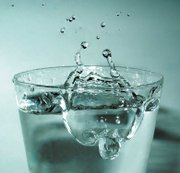Wednesday, August 29, 2012
Agua. Wasser. Eau. Voda. Maji. Regardless of what you call it, water serves the same function. Water is a necessary element; regardless of race, gender or age, we all need it. The Mayo Clinic reports that 60 percent of our body weight is made up of water. Our bodies would not function properly without water: It flushes toxins out of vital organs, carries nutrients to cells and provides a moist environment for ear, nose and throat tissues.
For years, we've heard that we should drink eight, 8-ounce glasses of water a day; however, some experts disagree with that advice.
One of those is researcher Heinz Valtin. He concluded in a 2002 study, published in the American Journal of Physiology, that inadequate evidence exists that healthy adults need large amounts of water. His study focused on people living in temperate climates (basically anywhere except the tropics and the poles) and not engaged in rigorous activities. For normal, healthy adults, Valtin recommended simply drinking when thirsty.
A recommendation issued in February 2004 by the Washington, D.C.-based Institute of Medicine reiterates Valtin's findings, although the IOM focus was more on a person's total fluid intake, rather than water alone.
The institute recommends 91 ounces of fluid (11 cups a day) for women and 125 ounces (15 cups a day) for men. These amounts include fluid from all food and beverages. On average, food provides about 20 percent of total fluid intake. Many fruits and vegetables, such as watermelon and tomatoes, are 90 percent or more water by weight. Lettuce, watermelon, broccoli, grapefruit, milk, orange juice, carrots and yogurt are all between 85 percent and 95 percent water.
You may need to modify your total fluid intake, up or down, depending on activity level, climate, heat exposure, health status, and whether you're pregnant or breast-feeding. Speak with your doctor if you need help determining the best amount of water for you.
Message in a Bottle
The U.S. Food and Drug Administration tests and regulates bottled water using many of the same parameters as the Environmental Protection Agency and municipalities use to test tap water. Some standards are stricter for tap water, others for bottled water. The FDA is responsible for inspecting and certifying the sources of natural water, which means it has analyzed samples and found them to be safe and sanitary. Here are some basic differences in the types of bottled water.
Spring water comes from a natural underground source and must be collected at the spring through boreholes tapping that source.
Mineral water also comes from natural, underground sources, but it contains some salt or sulfur compounds. Bottlers cannot add minerals; they must be part of the water.
Well water comes directly from a hole in the ground that taps the water source.
Artesian well water is water confined under pressure between layers of relatively impermeable, underground rock, called a confined aquifer. Artesian water rises to the top of the aquifer and sometimes above ground when a well taps the aquifer.
Purified water can come from any source, including ordinary municipal tap water. Bottlers use one of several methods—distillation, deionization or reverse osmosis—to kill bacteria and remove dissolved solids.
Sparkling water can also come from any source, but the FDA classifies it as a soft drink, not water. Examples include club soda, seltzer or tonic water. It contains carbon dioxide that gives it an effervescent quality and may also have added flavors.
The bottled-water industry isn't going away, but the resulting mountains of discarded plastic bottles are an environmental problem. Many municipalities have banned sales of bottled water and, in February, the National Park Service banned sales at the Grand Canyon.
To reduce your carbon footprint and save some moolah, purchase reusable water bottles with built-in filters, fill them and refrigerate. You can also invest in filtering pitchers or permanent under-sink or faucet-mounted filters to improve the water in your home.
Some experts warn against re-using single-use plastic bottles due to chemical leaching and bacterial hazards from improper cleaning. It may also be worth it to purchase a reusable water bottle to tote your filtered water.
